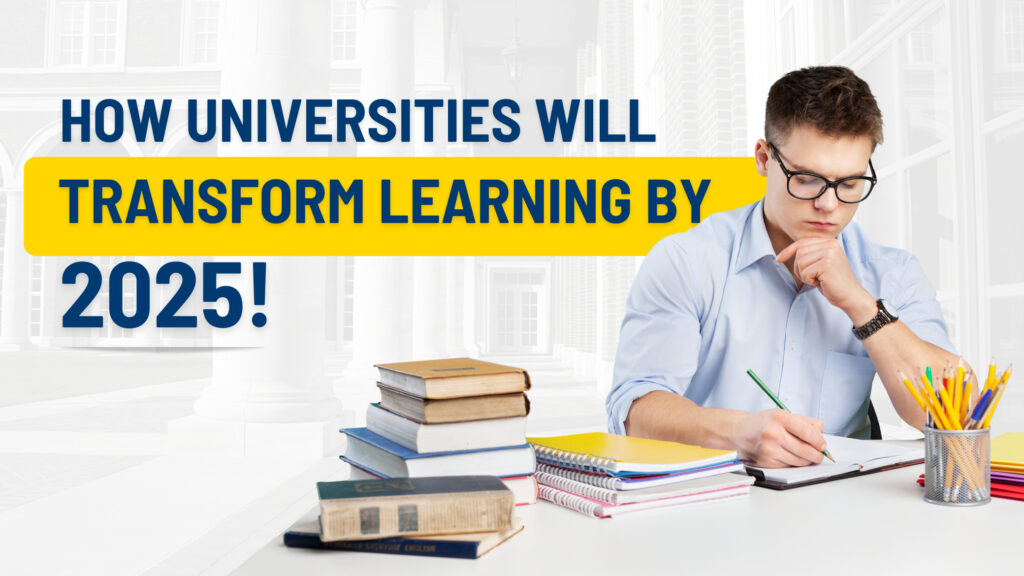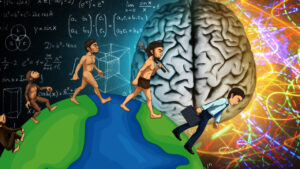Revolutionary Learning Models Universities Will Adopt by 2025
As we approach 2025, the landscape of higher education is set for a dramatic transformation with the adoption of revolutionary learning models universities will adopt worldwide. These new university models promise to redefine how education is delivered and experienced, making it more tailored, flexible, and technology-driven. By integrating personalized learning, blended approaches, and advanced technologies, institutions will create educational experiences that better meet the diverse needs of students.

I will delve into the key trends that will shape the future of academia, including personalized learning, blended learning, and the integration of AI and data analytics. By understanding these innovative approaches, we can better anticipate how universities will evolve to meet the diverse needs of students and prepare them for a rapidly changing world.
Future of Education: Key Trends to Watch
As education rapidly evolves, universities are adopting forward-thinking strategies to enhance student learning and engagement. The key trends shaping this transformation include personalized learning, blended learning, and the integration of AI into education. These approaches not only address the diverse needs of students but also aim to improve the overall quality of education. Let’s see how these trends are setting the foundation for the future of education.
1. Personalized Learning: Tailoring Education to Individual Needs
Personalized learning has a groundbreaking approach that centers the educational experience around each student’s unique needs, preferences, and pace. Unlike traditional one-size-fits-all models, personalized learning allows students to receive tailored instruction based on their strengths, interests, and learning styles. This shift is made possible through adaptive learning technologies, which continuously assess a student’s progress and adjust the curriculum accordingly.
For example, if a student excels in mathematics but struggles with writing, personalized learning platforms can offer additional resources or provide more focused assignments to improve writing skills. By 2025, more universities will implement this approach, allowing students to follow custom learning paths that lead to better engagement and academic success.
Transitioning into the Future: Personalized learning promotes active participation by giving students greater control over their educational journey. As technology continues to advance, the use of AI and data analytics will play a central role in refining personalized learning systems, ensuring they become more intuitive and effective.
2. Blended Learning: Combining Online and In-Person Instruction
Blended learning, a hybrid approach that seamlessly combines online and traditional classroom instruction, has rapidly gained traction in recent years. By offering the flexibility of digital learning alongside the benefits of face-to-face interaction, universities are actively creating more dynamic and adaptable educational environments. Students now access digital lectures, complete online assessments, and then participate in in-person discussions or lab sessions to reinforce their understanding.
This model not only addresses diverse learning preferences but also accommodates students with varying schedules, enabling them to balance academic responsibilities with personal commitments. Blended learning equips students for a world increasingly dependent on digital skills and remote collaboration, making it an essential tool in modern education.
Transitioning to a New Norm: Flexibility of blended learning actively boosts student engagement by providing diverse learning formats, fostering collaboration, and encouraging critical thinking. As more universities continue to adopt this model, they will increasingly integrate emerging technologies like augmented reality (AR) and virtual reality (VR) to further enhance the learning experience.
3. AI in Education: Transforming Teaching and Learning
Artificial Intelligence (AI) is already transforming how education is delivered, offering powerful new tools for both students and educators. AI-powered systems efficiently automate routine tasks such as grading assignments and managing administrative processes. As a result, educators can now focus more on meaningful activities, like mentoring students and developing innovative curriculum strategies.
AI also delivers personalized tutoring solutions, providing students with immediate feedback and tailored suggestions for improvement. For instance, AI-driven platforms monitor student performance in real-time, identifying areas where they struggle and offering specific resources to help them improve. This proactive approach ensures students receive timely, targeted assistance, reducing the risk of them falling behind.
Looking Ahead: Role of AI in education will continue to expand as universities aim to enhance both teaching efficiency and student learning outcomes. By utilizing AI to improve personalization, streamline administrative tasks, and deliver data-driven insights, universities are shaping a more adaptive and responsive learning environment for the future.
1. Innovations in Personalized Learning
Landscape of education is undergoing a transformation with innovations in personalized learning. These advancements cater to the individual needs of students, making learning more flexible, efficient, and tailored. By leveraging adaptive technologies and data-driven strategies, universities can now deliver customized learning experiences that were once unimaginable. Below are the key innovations driving this shift in education.
1.1. Adaptive Learning Technologies
Adaptive learning technologies are revolutionizing the way students engage with educational content. These systems adjust learning materials in real-time, based on individual student performance. By analyzing how a student interacts with lessons, these technologies modify the pace, difficulty, and type of content presented. For example, if a student struggles with a specific concept, the platform will offer additional resources or adjust the level of difficulty to help them understand the material better.
This personalized approach makes learning more efficient by focusing on areas where students need the most improvement. Instead of a one-size-fits-all model, adaptive learning tailors the educational experience to each learner’s unique needs. As universities continue to adopt adaptive learning technologies, they will significantly enhance student success and retention rates.
Looking Forward: These technologies are not just a supplement to traditional learning; they are actively shaping the future of education by making instruction more personalized, efficient, and engaging.
1.2. Data-Driven Insights for Custom Learning Paths
Data analytics plays a essential role in creating custom learning paths for students. By leveraging vast amounts of data on student performance, universities can offer tailored educational experiences that maximize learning outcomes. For instance, learning management systems (LMS) now track metrics like quiz scores, participation rates, and time spent on activities. This data helps identify trends and patterns, enabling educators to intervene early and offer targeted support.
Custom learning paths powered by data-driven insights allow for a more personalized and efficient learning journey. Universities can use this information to develop course content that matches the strengths, weaknesses, and interests of individual students. This makes learning more relevant and engaging while ensuring that students stay on track to meet their academic goals.
Moving Forward: Data-driven insights will continue to reshape higher education by enabling more personalized, flexible, and responsive learning models.
1.3. Benefits and Challenges of Personalized Learning
Personalized learning offers numerous benefits that transform the traditional educational experience. One major advantage is that it addresses the unique needs of each student, ensuring they receive the support they require. This individualized approach often leads to higher engagement and better academic outcomes. Students who might struggle in a standardized classroom can now learn at their own pace, reinforcing their understanding before moving on to more advanced topics.
Personalized learning also presents challenges. Implementing adaptive technologies and data-driven insights requires significant investments in infrastructure and training. Universities must ensure that educators are well-equipped to use these tools effectively. Concerns about data privacy and the potential for unequal access to technology remain key issues. Addressing these challenges is important for fully realizing the benefits of personalized learning.
Looking Ahead: While personalized learning offers great promise, universities will need to navigate the logistical, financial, and ethical challenges involved in order to make it widely accessible.
2. Rise of Blended and Hybrid Learning Models
As educational institutions evolve, the demand for more flexible and adaptable learning models is becoming increasingly evident. Blended and hybrid learning models are at the forefront of this transformation, combining the best of online and in-person education. By integrating technology with traditional teaching methods, universities can create a more dynamic and accessible learning environment. Below are some models and the technologies driving their success.
2.1. What is Blended Learning?
Blended learning merges online education with traditional classroom instruction, creating a comprehensive learning experience. In this model, students have the flexibility to access digital resources, complete assignments online, and engage in interactive modules at their own pace. At the same time, they benefit from face-to-face interactions, discussions, and in-person assessments.
This approach offers a unique blend of convenience and engagement. For instance, students might attend lectures online and participate in discussions or group projects during on-campus sessions. The digital component allows learners to review materials as needed, while the in-person aspect encourages collaboration and real-time feedback.
Transitioning to the Future: As universities adopt blended learning models, they’re reshaping how education is delivered. This model not only accommodates diverse learning preferences but also prepares students for a world increasingly reliant on digital tools and remote work.
2.2. Role of Virtual Reality (VR) and Augmented Reality (AR)
Virtual Reality (VR) and Augmented Reality (AR) are revolutionizing blended learning by creating immersive, interactive experiences. These technologies allow students to engage with complex subjects in ways that were previously impossible. For instance, VR can simulate real-world scenarios, enabling students to explore historical events or conduct virtual laboratory experiments.
AR, on the other hand, overlays digital information onto the physical world, enhancing the learning experience. Imagine a medical student using AR to visualize a 3D model of the human body, allowing them to interact with and study anatomy in detail. Both VR and AR bring abstract concepts to life, making learning more engaging and effective.
Next Step: As VR and AR become more integrated into blended learning models, students will experience a more hands-on approach to education, whether they’re studying history, science, or art. These technologies will bridge the gap between theoretical knowledge and practical application.
2.3 How Hybrid Learning Supports Global Accessibility
Hybrid learning, a variation of blended learning, supports global accessibility by offering both online and offline components, making education more inclusive. This model allows students from different geographical locations to access high-quality education without the need to relocate or attend full-time on-campus classes.
For international students or those with work commitments, hybrid learning provides a flexible solution. They can participate in online lectures, complete coursework remotely, and attend occasional in-person sessions or assessments. This flexibility is particularly valuable in a world where remote learning has become the norm, allowing students to pursue education while balancing their personal and professional lives.
Looking Forward: Hybrid learning models will continue to expand access to education, breaking down geographical barriers and offering students around the world the opportunity to learn from top institutions.
3. AI and Data Analytics: Shaping the Future of Higher Education
landscape of higher education is undergoing a transformation driven by artificial intelligence (AI) and data analytics. These technologies are not only enhancing the learning experience but are also reshaping university administration and student outcomes. With the rapid advancement of AI, universities are adopting new tools and strategies to improve the quality of education and streamline their operations.
Here, we will know how AI-powered educational tools, data analytics, and AI’s impact on university administration are shaping the future of higher education.
3.1. AI-Powered Educational Tools
AI-powered educational tools are revolutionizing how students learn and how instructors teach. These tools offer personalized learning experiences, making education more engaging and accessible. AI-driven platforms, such as intelligent tutoring systems, can adapt to each student’s learning style, providing real-time feedback and support. For instance, AI algorithms can identify when a student is struggling with a particular topic and offer tailored exercises to improve their understanding.
AI is being integrated into learning management systems (LMS) to automate administrative tasks like grading and attendance tracking. This allows educators to focus more on teaching and less on paperwork. AI-powered chatbots and virtual assistants are helping students with queries related to their courses, assignments, and campus services, creating a more responsive and supportive academic environment.
Transitioning from traditional methods to AI-powered tools is allowing universities to not only enhance learning but also improve student retention. These tools offer flexibility in pacing, making it easier for students to manage their studies while juggling other commitments. As AI tools become more sophisticated, we can expect further integration into classrooms, paving the way for a more customized and efficient learning experience.
3.2. Using Data Analytics to Enhance Student Outcomes
While AI transforms the delivery of education, data analytics plays an equally important role in improving student outcomes. Universities are leveraging data to gain insights into student behavior, performance, and engagement. By analyzing data from various sources—such as coursework, attendance, and extracurricular activities—institutions can identify at-risk students early and intervene with targeted support.
Data analytics is enabling educators to make informed decisions about curriculum design and teaching strategies. For example, if data shows that a significant number of students are failing a particular course, the university can analyze the curriculum and identify potential areas for improvement. This data-driven approach ensures that educational programs are continuously optimized to meet the evolving needs of students.
Predictive analytics is becoming increasingly common in higher education. Universities are using historical data to predict student success and retention rates. These insights allow administrators and educators to develop personalized support plans that cater to the unique needs of each student. As a result, students receive tailored resources that help them stay on track, graduate on time, and achieve better academic outcomes.
3.3. Impact of AI on University Administration
Beyond the classroom, AI is having a profound impact on university administration. Administrative tasks that once required significant human resources, such as admissions, scheduling, and resource management, are now being streamlined by AI solutions. For example, AI-driven admissions systems can evaluate applications more efficiently, using algorithms to match prospective students with the programs best suited to their skills and interests.
AI is also playing a key role in optimizing campus operations. Universities are using AI to manage everything from building energy usage to resource allocation, helping institutions run more efficiently and sustainably. AI-based systems can analyze historical data to predict future trends in enrollment and funding, allowing universities to plan for growth or changes in student demographics.
AI is helping universities improve communication and engagement with students. Chatbots and virtual assistants are being used to answer frequently asked questions, provide course recommendations, and assist with administrative processes, reducing the workload for university staff. This not only improves operational efficiency but also enhances the student experience by providing faster, more accurate responses to their inquiries.
As AI continues to evolve, it is clear that its impact on university administration will only grow. Institutions that AI and data analytics are better equipped to meet the challenges of the future and provide a more effective, student-centered education.
These adopting these Revolutionary Learning Models in Universities innovative approaches are reshaping. By these changes, educational institutions will better prepare students for a rapidly evolving world, fostering a more effective and responsive academic environment. Future of education is bright, and these trends promise to make learning more accessible and tailored to individual needs.







